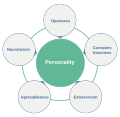Big Five personality traits
Big Five personality traits refer to a theoretical model in psychology that describes human personality through five broad dimensions. These dimensions are Openness, Conscientiousness, Extraversion, Agreeableness, and Neuroticism, often abbreviated as OCEAN. The Big Five model is widely accepted and utilized in the field of psychology for research, assessment, and understanding of individual differences in personality.
Overview[edit]
The Big Five personality traits are based on the idea that five main dimensions are sufficient to capture the variations in human personality. Each trait represents a spectrum between two extremes. For example, Extraversion includes qualities from outgoing and energetic to solitary and reserved. The model does not prescribe any specific behavior but rather describes tendencies in behavior, emotion, and thought.
Openness[edit]
Openness to Experience describes a dimension of personality that distinguishes imaginative, creative individuals from down-to-earth, conventional people. It includes traits related to intellectual curiosity, preference for novelty, and a tolerance for ambiguity.
Conscientiousness[edit]
Conscientiousness refers to the degree to which a person is reliable, organized, and diligent. High levels of conscientiousness are associated with a preference for planning and dependability, whereas lower levels are linked to flexibility and spontaneity.
Extraversion[edit]
Extraversion is characterized by an energetic approach towards the social and material world. It includes traits such as sociability, assertiveness, and the tendency to seek stimulation in the company of others.
Agreeableness[edit]
Agreeableness reflects individual differences in concern with cooperation and social harmony. Agreeable individuals are compassionate and cooperative, while those low in agreeableness may be more competitive or challenging in social contexts.
Neuroticism[edit]
Neuroticism measures the tendency to experience negative emotions, such as anxiety, anger, or depression. High levels of neuroticism are associated with emotional instability and vulnerability to stress, whereas low levels indicate emotional resilience and stability.
Measurement[edit]
The Big Five personality traits are typically measured through self-report questionnaires, where individuals rate the extent to which they agree with statements related to each trait. The most widely used measures include the NEO Personality Inventory and the Big Five Inventory (BFI).
Applications[edit]
The Big Five model has applications in various fields, including psychology, psychiatry, education, and occupational psychology. It is used in personality assessment, mental health diagnosis, career counseling, and understanding group dynamics.
Criticism and Alternatives[edit]
While the Big Five model is widely accepted, it has faced criticism for oversimplifying the complexity of human personality and for its cultural bias, primarily reflecting Western perspectives. Alternative models, such as the HEXACO model, which adds a sixth dimension of Honesty-Humility, have been proposed to address these limitations.
Conclusion[edit]
The Big Five personality traits provide a comprehensive framework for understanding human personality. Despite its limitations, the model's simplicity and empirical support make it a valuable tool in both research and applied settings.

This article is a psychology-related stub. You can help WikiMD by expanding it!
-
Big Five Personality Traits Diagram
-
Retos Twins
-
Chimpanzees
-
Heroin Psycho Profile
-
Occupation Personality Vocation Map
-
Employees Discuss in Office
-
CC-BY Icon
Ad. Transform your life with W8MD's Budget GLP-1 injections from $75


W8MD offers a medical weight loss program to lose weight in Philadelphia. Our physician-supervised medical weight loss provides:
- Weight loss injections in NYC (generic and brand names):
- Zepbound / Mounjaro, Wegovy / Ozempic, Saxenda
- Most insurances accepted or discounted self-pay rates. We will obtain insurance prior authorizations if needed.
- Generic GLP1 weight loss injections from $75 for the starting dose.
- Also offer prescription weight loss medications including Phentermine, Qsymia, Diethylpropion, Contrave etc.
NYC weight loss doctor appointmentsNYC weight loss doctor appointments
Start your NYC weight loss journey today at our NYC medical weight loss and Philadelphia medical weight loss clinics.
- Call 718-946-5500 to lose weight in NYC or for medical weight loss in Philadelphia 215-676-2334.
- Tags:NYC medical weight loss, Philadelphia lose weight Zepbound NYC, Budget GLP1 weight loss injections, Wegovy Philadelphia, Wegovy NYC, Philadelphia medical weight loss, Brookly weight loss and Wegovy NYC
|
WikiMD's Wellness Encyclopedia |
| Let Food Be Thy Medicine Medicine Thy Food - Hippocrates |
Medical Disclaimer: WikiMD is not a substitute for professional medical advice. The information on WikiMD is provided as an information resource only, may be incorrect, outdated or misleading, and is not to be used or relied on for any diagnostic or treatment purposes. Please consult your health care provider before making any healthcare decisions or for guidance about a specific medical condition. WikiMD expressly disclaims responsibility, and shall have no liability, for any damages, loss, injury, or liability whatsoever suffered as a result of your reliance on the information contained in this site. By visiting this site you agree to the foregoing terms and conditions, which may from time to time be changed or supplemented by WikiMD. If you do not agree to the foregoing terms and conditions, you should not enter or use this site. See full disclaimer.
Credits:Most images are courtesy of Wikimedia commons, and templates, categories Wikipedia, licensed under CC BY SA or similar.
Translate this page: - East Asian
中文,
日本,
한국어,
South Asian
हिन्दी,
தமிழ்,
తెలుగు,
Urdu,
ಕನ್ನಡ,
Southeast Asian
Indonesian,
Vietnamese,
Thai,
မြန်မာဘာသာ,
বাংলা
European
español,
Deutsch,
français,
Greek,
português do Brasil,
polski,
română,
русский,
Nederlands,
norsk,
svenska,
suomi,
Italian
Middle Eastern & African
عربى,
Turkish,
Persian,
Hebrew,
Afrikaans,
isiZulu,
Kiswahili,
Other
Bulgarian,
Hungarian,
Czech,
Swedish,
മലയാളം,
मराठी,
ਪੰਜਾਬੀ,
ગુજરાતી,
Portuguese,
Ukrainian





